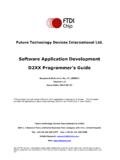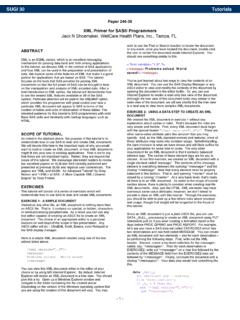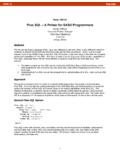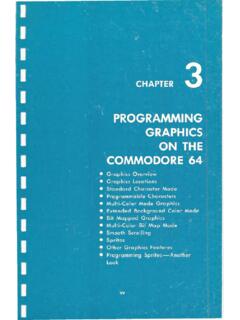Transcription of Proc SQL – A Primer for SAS Programmers
1 Proc SQL A Primer for SAS Programmers Jimmy DeFoor Citi Card Irving, Texas The Structured Query Language (SQL) has a very different syntax and, often, a very different method of creating the desired results than the SAS Data Step and the SAS procedures. Only a very thorough manual, such as the SAS Guide to the Proc SQL Procedure, could even begin to describe well the complete syntax and the full capabilities of Proc SQL. Still, there is value in presenting some of the simpler capabilities of Proc SQL, especially those that are more efficient or easier to code than the SAS Data Step. The reasons: 1) the tables created by Proc SQL can be read by the SAS Data Step or SAS procedures, so the SAS programmer can choose to use only some SQL code without impacting the rest of his or her SAS code; 2) understanding Proc SQL can aid the programmer in understanding other DB2, T-SQL, PL-SQL and other SQL code.
2 This paper will assume that the reader is a capable SAS programmer , but is fairly uninformed about Proc SQL. It will use familiar coding techniques in the SAS Data Step and SAS procedures to teach the syntax and function of Proc SQL as it shows some of the unique capabilities of the Proc SQL. The first example involves creating a simple output listing in Proc SQL vs Proc Print. Creating an Output Listing with Proc SQL vs a Data Step Filename out C :\ new; /* assign output to a file */ Proc Printo print=out; Run; /* print contents of variables */ Proc SQL; Select montonic() as obs, , as Town, , , , , , from a; quit; Filename out C :\ new; /* assign output to a file */ Proc Printo print=out; Run; /* print contents of variables */ Proc Print data = ; Label City = Town ; Var State City Store Year Month Sales VarCost FixedCost; Run.
3 Since Proc SQL is a procedure, it requires a Proc Printto to be used before it is executed if the listing output is to be directed to a text file instead of the default list file SAS uses. Proc Print has the same requirement Proc Print generates observation numbers automatically; Proc SQL doesn t. Only by adding the little documented function of monotonic can observation numbers be generated. Notice the as reference that follows the function. An as reference uses the name that follows to name the result of the function. It can also be used to rename variables: here, it is used to rename City to Town.
4 A Label statement in the Proc Print example accomplishes the same result. Compare the syntax of the Proc Print to the syntax of Proc SQL. Commas separate the variables listed in the Select statement of Proc SQL. The Quit statement is the terminator of Proc SQL, not the Run statement. The semi-colon does not end every instruction, as it does in usual SAS code; instead, it ends only the SQL Select statement, which is really the only statement in SQL When SAS encounters the semi-colon that ends the Select statement, it passes all of the preceding SQL code to the SQL compiler. The compiler separates the Select statement into individual SQL clauses as it encounters such key words as From, Where, and On.
5 It then evaluates the clauses and passes them to the execution module if they are 84 syntactically correct. Thereafter, SQL processes all of the clauses and waits for another Select statement unless it encounters a Quit statement or another SAS step. Thus, Proc SQL can create multiple tables and/or listings until it is closed. The variables listed in Proc SQL can be defined relative to the data set in which they occur. The programmer can create an alias by following the table name with a shorter name ( a , in the examples below). He or She can then attach the alias to the front of the variable name with a period.
6 This ability to reference variables by their data sets allows multiple variables with the same name to be manipulated by Proc SQL. This will be shown in a later example when a data set is created by joining two data sets. Our next example shows the simplest way of creating a SAS data set: reading into it all the variables and records of another SAS data set. Notice that the Select * statement is used to specify that all variables are to be retrieved from the Measures data set. The SAS Data Step retrieves all variables by default. Only the presence of a Keep or Drop statement as a Data Set option prevents all variables in the input data set from being read into the SAS Data Step.
7 SQL either retrieves all variables or only the specified variables. It does not explicitly drop variables. Creating a Table with Proc SQL compared to Creating It with a Data Step, Example 1 Proc SQL; Create Table Work1 as Select * from a; quit; Data Work1; Set ; Output; Run; The syntax of the SAS Data Step states that it creates a data set, while the syntax of Proc SQL states that it creates a table, but SAS treats them as equals. The SAS Data Step can read a Proc SQL table and Proc SQL can read a SAS Data Set. Both entities are called tables by SAS when viewed in its explorer window (when details is tuned on).
8 The example that follows has the Select statement retrieving particular variables from the Measures data set and writing them to the table Sales. As discussed earlier, the Data Step must accomplish the same result with a keep action - in this case, the Keep= data set option. However, the Select statement has another result that cannot be easily duplicated in the SAS data step. It orders the variables as it retrieves them. Keep, in any form, does not specify order. Only Length statements or Format statements set order in a Data Step and they must be placed before the Set statement if they are going to determine the order of all variables in the data set.
9 The problem is, however, that they require some knowledge of the variables content and existing formats if they are to be used effectively. The SQL Select statement does not require such knowledge. On the other hand, though the Data Step cannot match the ease of variable ordering that can be done in Proc SQL, it can perform multiple record outputs to the same data set or record outputs to multiple data sets with great ease. For example, the data statement below could easily be modified to write part of the record to Sales and part to a data set named CityList. Data Sales(keep=Sales) CityList(keep=City); Creating a Table with Proc SQL compared to Creating It with a Data Step, Example 2 Proc SQL; Create Table Sales as Select , , , , , from a; quit; Data Sales; Length State $12 City $20 Store $06 Year $04 Month $02 Sales 8; Set (keep= State City Store Year Month Sales); Output; Run; 85 The Match-Merge Syntax of Proc SQL Compared to the Data Step Proc SQL.
10 Create Table Joined as Select , , , , , , , from a left outer join b On = ; quit; Data Joined; Merge (in=c keep=City) (in=m keep=State Store Year Month Sales VarCost FixedCost) By city; If c then output; run; These SAS code match-merges a list of selected cities with the Measures data set and keeps only the cities in Measures that match the cities in ParticularCities. The SQL code does the same thing, but the action is called an equijoin instead of a match-merge.








